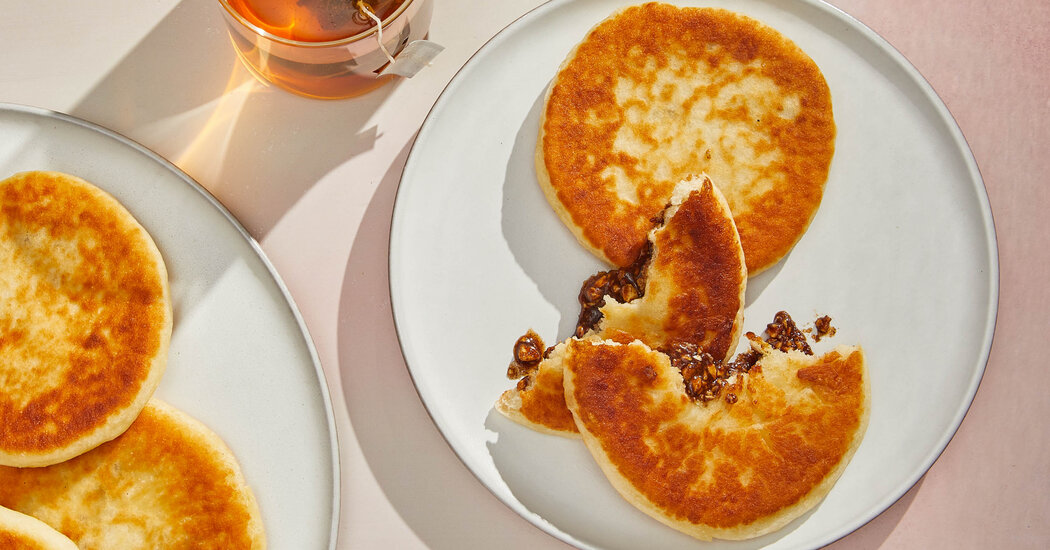
The most challenging part of eating hotteok is the waiting, said the chef Judy Joo. It takes a few minutes for the hot sugar encased in the crisp, chewy pancakes to go from molten, burn-your-mouth-off goo to warm, sticky goodness.
As a child, she visited stalls in Seoul that sold the Korean treat during the winter. “It was torture, standing there in the cold” with the joyful scent of sugar and cinnamon filling the air, she said.
These days, Ms. Joo, 47, a chef and cookbook author, makes her own hotteok at home on the Upper West Side of Manhattan. She combines bread flour with sweet rice flour, and stuffs each pancake with a filling of muscovado, peanuts, cinnamon and salt, then fries the plump rounds until they’re a brilliant golden brown.
Hotteok (pronounced somewhere between HO-tuck and HO-duck) comes in both sweet and savory versions, from mozzarella to matcha, though the cinnamon-and-sugar filling is among the most popular nowadays. At Jinjuu, the Korean restaurant in London that Ms. Joo ran until 2019, one of her top-selling dishes was a Snickers-inspired hotteok, with a filling of salted caramel, chocolate ganache, peanut butter and praline.
Ms. Joo isn’t the only Korean chef experimenting with hotteok. At Mokbar, in New York, Esther Choi fills hers with pork belly. Sammy Pak has sold one with ham and cheese at his pop-up, Sammy’s, in Oakland, Calif. Frankseoul, a South Korean cafe chain that opened a Frisco, Texas, location in 2020, offers Nutella-filled hotteok. (Trader Joe’s began selling its own “sweet cinnamon filled Korean pancakes” last year.)
Despite all that innovation, JinJoo Lee, 55, who writes the Korean-food blog Kimchimari, said the dish feels more nostalgic to people of her generation, who grew up in the 1970s and ’80s. For them, it’s reminiscent of a time when there was little foreign influence on South Korean foods, as that country was under authoritarian rule.
Yet hotteok itself is a product of outside forces. It was brought to the country by Chinese immigrants in the late 19th century, as an adaptation of bing. The sweet variation became popular in the 1950s and ’60s, when American foreign aid after the Korean War introduced inexpensive wheat and sugar to the country. Hotteok was cheap to make and sell — convenient for a time when South Korea’s economy was struggling.
Today’s young Koreans may not have grown up with hotteok, Ms. Lee said. In fact, many food stalls that sold hotteok are now gone, as the government severely restricted street vendors during the 1988 Olympic Games in Seoul, claiming that the stalls made the city less walkable.
But recently, as those young people have reached adulthood, many have rediscovered hotteok, she said. “It is making a comeback.”
“With the popularity of K-dramas and K-pop, there is an interest in Korean food,” said John Lie, a professor of sociology at the University of California, Berkeley. (Members of the Korean pop band BTS recently posted online photos of themselves eating hotteok.) “Both the K-pop Stars and Korean drama stars, they are constantly eating Korean food.”
At Jua, a Korean tasting-menu restaurant in Manhattan, the chef Hoyoung Kim serves hotteok as the final course, pan-fried to order and lacquered with a syrup made of muscovado. He wanted to show that the humble dish could be part of a fine-dining experience.
“It’s more than a street food,” said Mr. Kim, 36. “It’s a Korean soul food.”
Recipe: Hotteok (Sweet Filled Pancakes)



